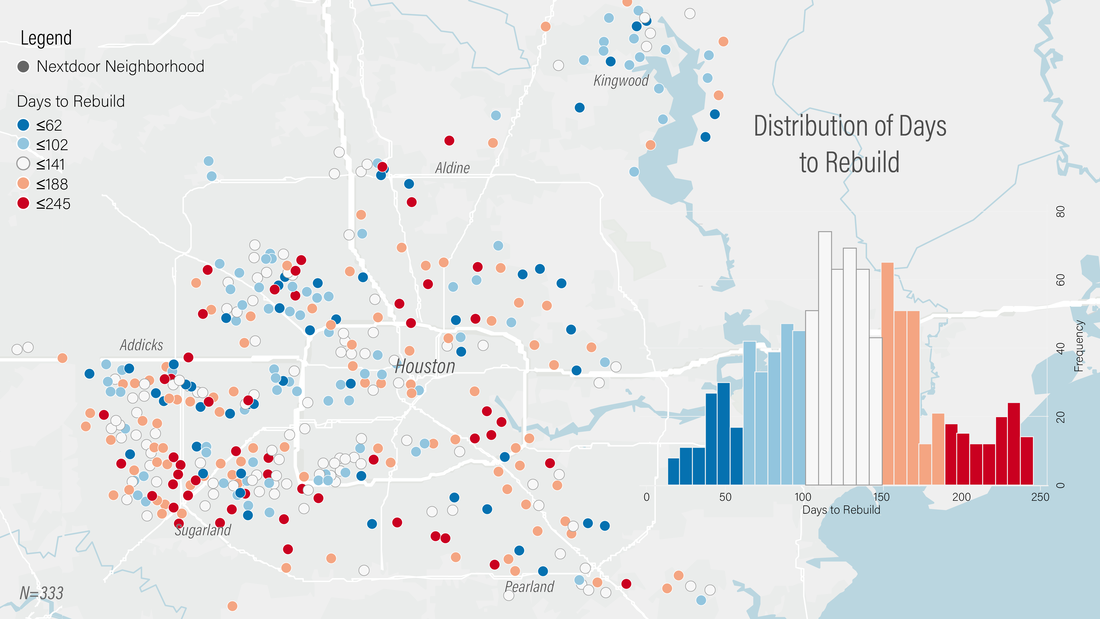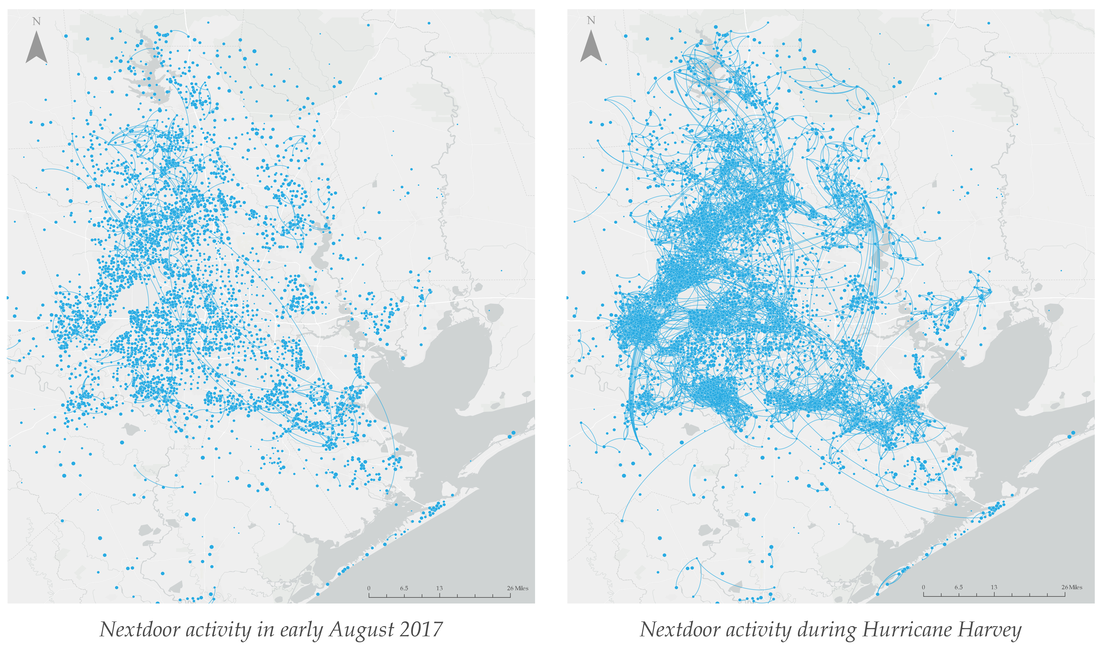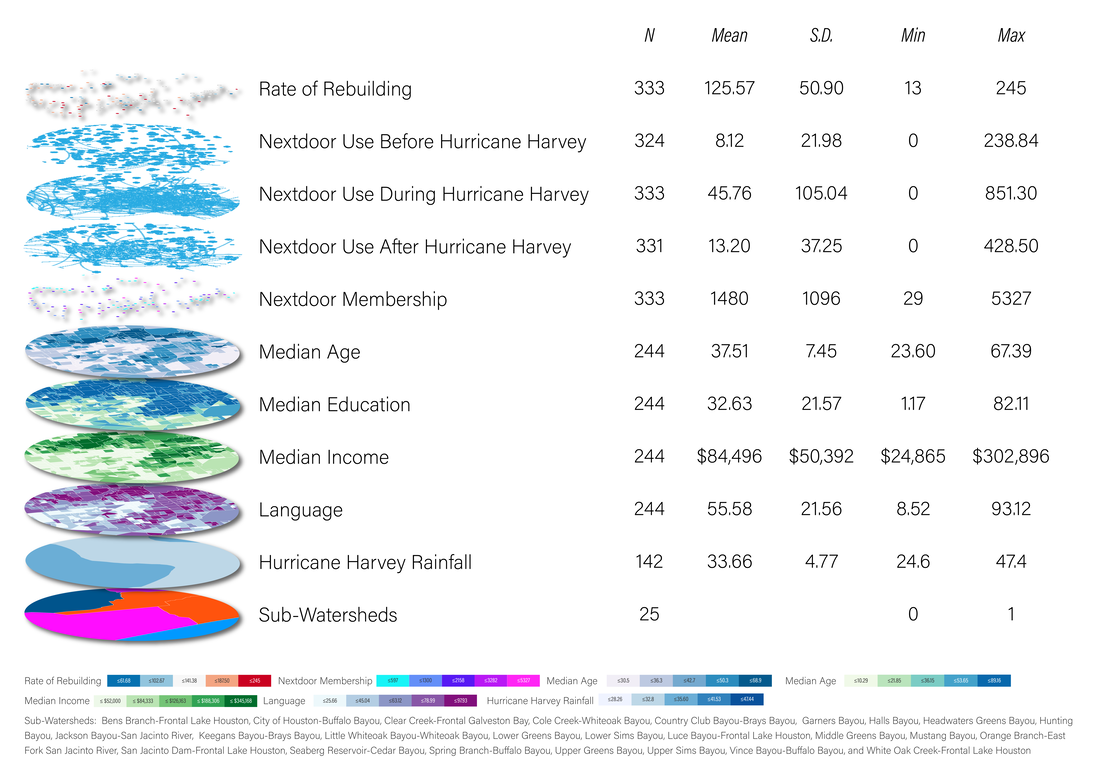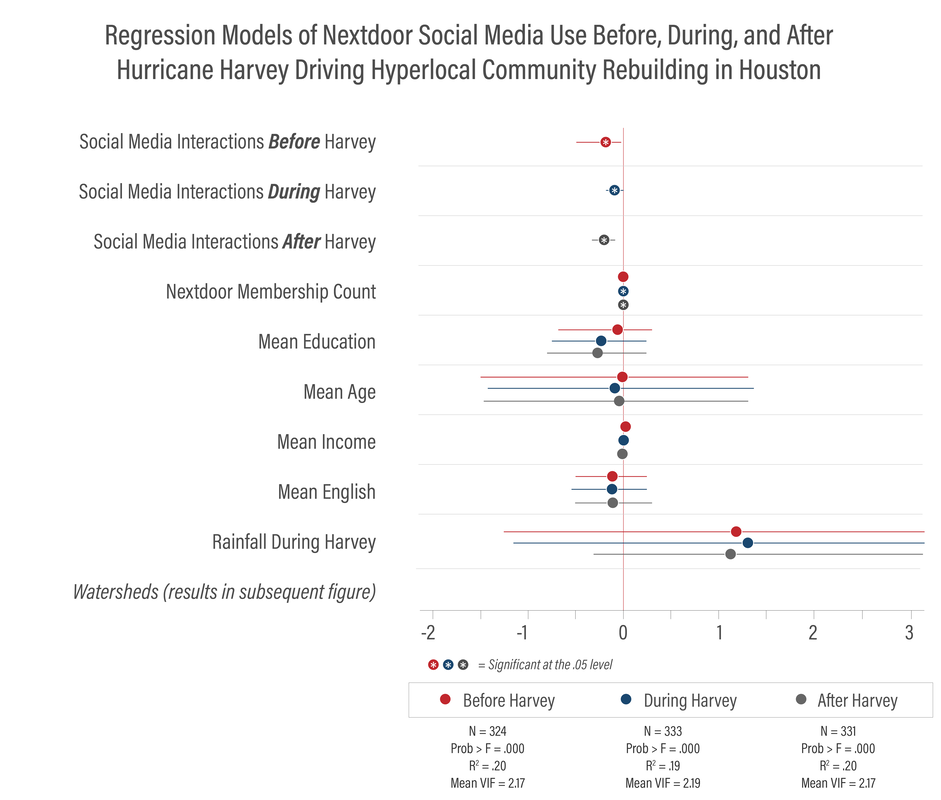- Covid-19 to go? The role of disasters and evacuation in the Covid-19 pandemic (Global Environmental Change: Human and Policy Dimensions)
- Techniques for social network analysis for disaster evacuation, recovery, and response (Research Methods of Disaster and Emergency Management: Approaches in Application)
- The role of social media in disaster recovery following Hurricane Harvey (Journal of Homeland Security and Emergency Management)
COVID-19 TO GO?
THE ROLE OF DISASTERS AND EVACUATION IN THE COVID-19 PANDEMIC
Abstract
Since the start of the pandemic, some U.S. communities have faced record storms, fires, and floods. Communities have confronted the increased challenge of curbing the spread of COVID-19 amid evacuation orders and short-term displacement that result from hazards. This raises the question of whether disasters, evacuations, and displacements have resulted in above-average infection rates during the COVID-19 pandemic. This study investigates the relationship between disaster intensity, sheltering-in-place, evacuation-related mobility, and contagion following Hurricane Zeta in Southeastern Louisiana and The Wildfires in Napa and Sonoma Counties, California, known as the Glass Fire. We draw on data from the county subdivision level and mapped and aggregated tallies of Facebook user movement from the Facebook Data for Good program’s GeoInsights Portal. We test the effects of disasters, evacuation, and shelter-in-place behaviors on COVID-19 spread using panel data models, matched panel models, and synthetic control experiments. Our findings suggest associations between disaster intensity and higher rates of COVID-19 cases. We also find that while sheltering-in-place led to decreases in the spread of COVID-19, evacuation-related mobility did not result in our hypothesized surge of cases immediately after the disasters. The findings from this study aim to inform policymakers and scholars about how to better respond to disasters during multi-crisis events, such as offering hotel accommodations to evacuees instead of mass shelters and updating intake and accommodation procedures at shelters, such as administration temperature screenings, offering hand sanitizing stations, and providing isolated areas for ill evacuees.
Since the start of the pandemic, some U.S. communities have faced record storms, fires, and floods. Communities have confronted the increased challenge of curbing the spread of COVID-19 amid evacuation orders and short-term displacement that result from hazards. This raises the question of whether disasters, evacuations, and displacements have resulted in above-average infection rates during the COVID-19 pandemic. This study investigates the relationship between disaster intensity, sheltering-in-place, evacuation-related mobility, and contagion following Hurricane Zeta in Southeastern Louisiana and The Wildfires in Napa and Sonoma Counties, California, known as the Glass Fire. We draw on data from the county subdivision level and mapped and aggregated tallies of Facebook user movement from the Facebook Data for Good program’s GeoInsights Portal. We test the effects of disasters, evacuation, and shelter-in-place behaviors on COVID-19 spread using panel data models, matched panel models, and synthetic control experiments. Our findings suggest associations between disaster intensity and higher rates of COVID-19 cases. We also find that while sheltering-in-place led to decreases in the spread of COVID-19, evacuation-related mobility did not result in our hypothesized surge of cases immediately after the disasters. The findings from this study aim to inform policymakers and scholars about how to better respond to disasters during multi-crisis events, such as offering hotel accommodations to evacuees instead of mass shelters and updating intake and accommodation procedures at shelters, such as administration temperature screenings, offering hand sanitizing stations, and providing isolated areas for ill evacuees.
Citation: Page-Tan, C. and Fraser, T. (2022) Covid-19 to go? The role of disasters and evacuation in the Covid-19 pandemic. Global Environmental Change: Human and Policy Dimensions. https://doi.org/10.1016/j.gloenvcha.2022.102471
Techniques for social network analysis for disaster evacuation, recovery, and response
Abstract
Disaster survivors and scholars alike argue that the presence, dearth, and type of social networks in a community can enable or limit disaster adaptation, response, evacuation, and recovery. But what kinds of networks can we examine in disaster studies? This chapter seeks to make social network analysis methods accessible to students and scholars of disaster policy. Using a network of disaster reconstruction committee members after Japan’s 2011 tsunami and earthquake, we demonstrate different techniques for network visualization, analysis, and statistics. First, we introduce readers to the logic and types of networks they may encounter, drawing from recent examples. Second, we lay out a process for analyzing networks, describing centrality measures, visualization, and statistical models. These accessible techniques allow us to identify what kinds of social ties affect recovery and how we can leverage these to improve disaster outcomes.
Disaster survivors and scholars alike argue that the presence, dearth, and type of social networks in a community can enable or limit disaster adaptation, response, evacuation, and recovery. But what kinds of networks can we examine in disaster studies? This chapter seeks to make social network analysis methods accessible to students and scholars of disaster policy. Using a network of disaster reconstruction committee members after Japan’s 2011 tsunami and earthquake, we demonstrate different techniques for network visualization, analysis, and statistics. First, we introduce readers to the logic and types of networks they may encounter, drawing from recent examples. Second, we lay out a process for analyzing networks, describing centrality measures, visualization, and statistical models. These accessible techniques allow us to identify what kinds of social ties affect recovery and how we can leverage these to improve disaster outcomes.
Citation: Fraser, T., Page-Tan, C., and Aldrich, D.P. (2021) Techniques for social network analysis for disaster evacuation, recovery, and response in Jason D. Rivera, ed., Research Methods of Disaster and Emergency Management: Approaches in Application. Routledge. https://doi.org/10.4324/9780367823948-19
THE ROLE OF SOCIAL MEDIA IN DISASTER RECOVERY FOLLOWING HURRICANE HARVEY
Abstract
Hurricane Harvey was social media's first real stress test as a disaster response and recovery mechanism. A confluence of conditions makes it an ideal case study of social media's role in disaster recovery: the lack of a government-issued evacuation order, a call from government leadership for willing and able volunteers with a boat or high-water vehicle to perform life-saving rescues, and wide-spread adoption of social media platforms in the Houston area. While research on online social networks and disasters continues to grow, social scientists know little about how these online networks transform during a crisis and, further, how they drive disaster outcomes. With two original datasets, this study investigates how Houston's online social network transformed during Hurricane Harvey (2017), and the relationship between social media activity and post-Harvey recovery. The findings of a social network analysis (N= 2,387,610) and subsequent statistical analyses reveal the Houston-area online social network grew denser, clustered, and more efficient during the disaster. A spatial analysis and three separate regression models of activity before, during, and after Hurricane Harvey reveal that among 333 Nextdoor Neighborhoods, hyperlocal social media activity was a statistically significant predictor of the rate of rebuilding in these geographically based online communities. These findings suggest that policy and decision-makers should invest into online and offline hyperlocal social networks well before a disaster strikes, and leverage resources and legislation to maintain and strengthen the telecommunications and energy infrastructure that supports access to social media and telecommunications infrastructure during a time of crisis.
Hurricane Harvey was social media's first real stress test as a disaster response and recovery mechanism. A confluence of conditions makes it an ideal case study of social media's role in disaster recovery: the lack of a government-issued evacuation order, a call from government leadership for willing and able volunteers with a boat or high-water vehicle to perform life-saving rescues, and wide-spread adoption of social media platforms in the Houston area. While research on online social networks and disasters continues to grow, social scientists know little about how these online networks transform during a crisis and, further, how they drive disaster outcomes. With two original datasets, this study investigates how Houston's online social network transformed during Hurricane Harvey (2017), and the relationship between social media activity and post-Harvey recovery. The findings of a social network analysis (N= 2,387,610) and subsequent statistical analyses reveal the Houston-area online social network grew denser, clustered, and more efficient during the disaster. A spatial analysis and three separate regression models of activity before, during, and after Hurricane Harvey reveal that among 333 Nextdoor Neighborhoods, hyperlocal social media activity was a statistically significant predictor of the rate of rebuilding in these geographically based online communities. These findings suggest that policy and decision-makers should invest into online and offline hyperlocal social networks well before a disaster strikes, and leverage resources and legislation to maintain and strengthen the telecommunications and energy infrastructure that supports access to social media and telecommunications infrastructure during a time of crisis.
Citation: Page-Tan, C. (2020). The Role of Social Media in Disaster Recovery Following Hurricane Harvey. Journal of Homeland Security and Emergency Management, 18(1), 93-123. https://doi.org/10.1515/jhsem-2018-0054





